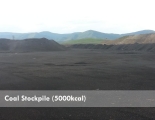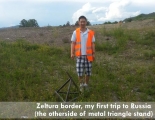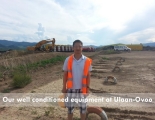NEWS
INVESTORKIT
- Mongolia Raises Electricity Prices for Miners
- Mongolia: Another Possible CHP5 Delay
- July 2013 - Executive Summary
- July 2013 - Company Presentation
- Latest News Release
STOCKINFO
| TSX: PCY | 0.12 | 0.00 |
|---|---|---|
| OTC-QX: PRPCF | 0.1188 | +0.0011 |
| Frankfurt: 1P2 | 0.082 | +0.001 |
Delayed by 20 minutes
Mongolia: Fast growing economy, evolving investment climate
High economic growth driven by Ming activity
Mongolia, entirely flanked to the north and south by Russia and China, is the most sparsely populated country in the world. However, the country has vast natural resources with more than 6,000 known mineral deposits of 80 different minerals. It has the potential to become a major player in global commodity markets with its rich gold, copper, zinc, uranium, coal, molybdenum and oil reserves.
Economic activity in Mongolia has traditionally been based on agriculture and the breeding of livestock. The economy underwent significant structural changes in the past and has since become increasingly reliant on the mineral sector. Ever since the early 1990’s Mongolia has been on a steady upward path recording real GDP growth every year except for 2009.
Figure 1: Structure change in Economy
There are two world class mines that hold the key to economic success in Mongolia, namely Tavan Tolgoi, one of the world’s largest coking coal deposits, and Oyu Tolgoi, the largest underdeveloped copper/gold project. The IMF estimated that export proceeds from these two mines could total US$2 billion in 2013, rising to US$7 billion by 2020, while Mongolia’s GDP in 2011 was only $8.8 billion.
With the expected $3 billion Tavan Tolgoi IPO this year and commercial production of Oyu Tolgoi to commence in first half 2013, it appears the Mongolia economy is poised to maintain good momentum. Mongolia’s average real GDP growth is projected to be 13.4% annually over the coming 5 years due to mining initiatives, according to IMF’s World Economic Outlook 2012.
Figure2: Real GDP growth rate: Mongolia vs. BRIC countries
Source: IMF-World Economic Outlook Oct 2012
Foreign direct investment -the lifeblood of Mongolian economy
Driven by the mining boom, Mongolia hit another historical peak in attracting foreign direct investments (FDI) in 2011. Total FDI to Mongolia amounted US$4.7bn, of which over 80% went to the mining sector, according to World Bank data. China, Canada and Netherlands are the top three investor countries by FDI amount in Mongolia.
Figure 3: FDI net inflows in Mongolia (US$ Billion)
Source: World Bank data Note: data are in current US dollars
Besides its attractive mineral resource, Mongolia’s very competitive raw material prices, low operating cost, low tax rate, favourable tax credit and cheap labour provides a favorable investment environment for foreign businesses. Mongolia’s regulatory environment is more conducive to the starting and operation of a local firm than its neighbors China and Russia, as Mongolia is continuing its positive run in the World Bank’s Ease of Doing Business 2012 ranking, moving from 88 to 76 out of 185 economies.
Figure 4: Ranking of Mongolia in ease of doing business - Compared to good practice and selected economies
Source: The World bank- Doing Business 2012 rankings
Key factors for accessing investment climate
Market confidence is turning around, as the Mongolia stock exchange Top 20 index has increased 20 percent from the bottom reached on Dec 1st 2012. It is important to review some of key factors for investment climate to get a better understanding of the Mongolia market performance.
Figure 5: One year Mongolia Stock Exchange Top 20 Index
Source: Bloomberg
Geopolitical stability
From an historical prospective, 20 years ago Mongolia made a transition from a one party political system into a democratic system. The United States Agency for International Development (USAID) praised Mongolia for its contribution to stability in a volatile part of the world, as well as its positive example in Asia in promoting economic reform and democracy.
In recent years, Mongolia has good standing across several governance indicators in comparison to other transitional and developing countries. The Economist Political Stability Index suggests that Mongolia fares above average in the world. Mongolia ranks 75th of 177 countries in 2013 Economic Freedom Index published by the Wall Street Journal, the Index evaluates countries in four areas of economic freedom: rule of law, regulatory efficiency, limited government and open markets. Mongolia improved its ranking on the list of most corrupt countries, recently ranked 94th out of 174 countries around the world, according to 2012 Corruption Perception Index, published by Transparency International.
With an expected increase in the mining sector and corresponding GDP growth, there is a growing concern about future political stability in Mongolia. Politically driven events in 2012, in particular the suspension of South Gobi Sands mining licenses in April and the request from government to renegotiate the Oyu Tolgoi investment agreement in October, have undermined the investment climate in Mongolia in the short term.
Frontier securities pointed out that political shock cast a shadow of negative sentiment on the Mongolia market, that manifest itself in the significant drop in Mongolian share prices, but the real economic engine is not much hindered. The rising political risk premium is not meant to discourage FDI; but investors should be cautious about the investment timing.
Country credit rating
Constrained by the country’s susceptibility by virtue of an undiversified economy and inflationary monetary and fiscal policy, Mongolia’s sovereign credit rating is in Speculative Grade, rated B1 by Moody’s , BB by Standard &Poor’s, and 6/9 by SINOSURE, an Chinese state-funded policy-oriented insurance company.
But with a dearth of sovereign paper in Asia, Mongolian bonds offer a chance for investors to diversify into one of the most attractive among emerging-market countries’ bonds. In November 2012, Mongolia sold $1.5 billion in debt in its first government bond offering, after raking in $15 billion of orders. The sale was equal to nearly one-fifth of the size of Mongolia’s economy and orders were roughly twice the size of the economy.
Mining Policy
According to the 2010/2011 Fraser Institute Annual Survey, Mongolia ranks 54th out of 79 districts in the world regarding the government mining policy index, higher than Russia (69/79), China (62/79), and is the second highest in Asia.
Figure 6: Mongolia’s mining index ranking compared with other Asian countries
Source: Fraser Institute 2010/2011 Survey of Mining Policy Index Ranking
Mongolia is collecting comments on draft revised minerals Law proposed in Dec 2012, which deviates from its 2006 Minerals Law in many areas and seeks to introduce a new regulatory regime including:
1.) The draft law defines water, oil, gas, radioactive minerals and rare earth elements as strategic minerals. Investors in its defined 15 strategically important deposits will need to establish an accord with the government and set up a “special regime” for mining such minerals.
2.) The Draft Law does impose requirements for local equity participation of mining licence holders.
3.) There are extensive regulations on environmental protection, mine closures, public consultations, agreements with local authorities, local content requirements, mandatory insurance policies, prohibitions on high-grading and feasibility studies.
The draft law, under fire from a number of sources and on a number of fronts, will likely undergo some significant amendments before it will be passed into law by Mongolia’s parliament.
The Strategic Entities Foreign Investment Law passed in May 2012 specifically limits the amount of FDI in the resource, media, and financial sectors respectively; and subjects these investments to government and parliamentary scrutiny. It undeniably prompted concerns among foreign investors about a more nationalistic approach to mining policy. The US embassy warned in its July Mongolia Investment Climate Statement that “investors can and should expect that investments, particularly in the resource sector, will be subject to volatile legal and regulatory regimes.” While The Economist Intelligence Unit points out the new government is unlikely to be able to alter the substance of recent resource deals.
Conclusion
Canada is the second largest foreign investor in Mongolia, with companies like Turquoise Hill Resources (formerly Ivanhoe Mines) and Prophecy Coal contributing heavily to the local economy. Unlike Canada, stability in the regulatory regime has not been a strong suit of the Mongolian mining environment.
On the way to developing into a country with a stable and fast growing economy and stable political and environmental conditions, Mongolia has been undergoing drastic socio-economic changes. It is important for the government to revise and update their policy stance to provide better protection to investors, the economy and its citizens. It is equally important for investors to review the investment climate in their decision-making before getting involved in the mining boom in Mongolia, while keeping in mind the idea that there is seldom reward without risk.
Written by: Leo Liu, MBA, CFA | [email protected]
Edited by: Chris Ackerman, BA, LLB | [email protected]
Leo Liu is a private investor and currently holds the position of Investor. Relations Officer with Prophecy Coal Corp. (TSX: PCY) and Prophecy Platinum Corp. (TSX.V: NKL).
Disclaimer: The views expressed in this article are those of the author and may not reflect those of Prophecy Coal Corp. Neither Prophecy Coal Corp. nor the author can guarantee accuracy of all information provided. This article is strictly for informational purposes only. It is not a solicitation to make any exchange in precious metal products, commodities, securities or other financial instruments. Prophecy Coal Corp. and the author of this article do not accept culpability for losses and/ or damages arising from the use of this publication.




